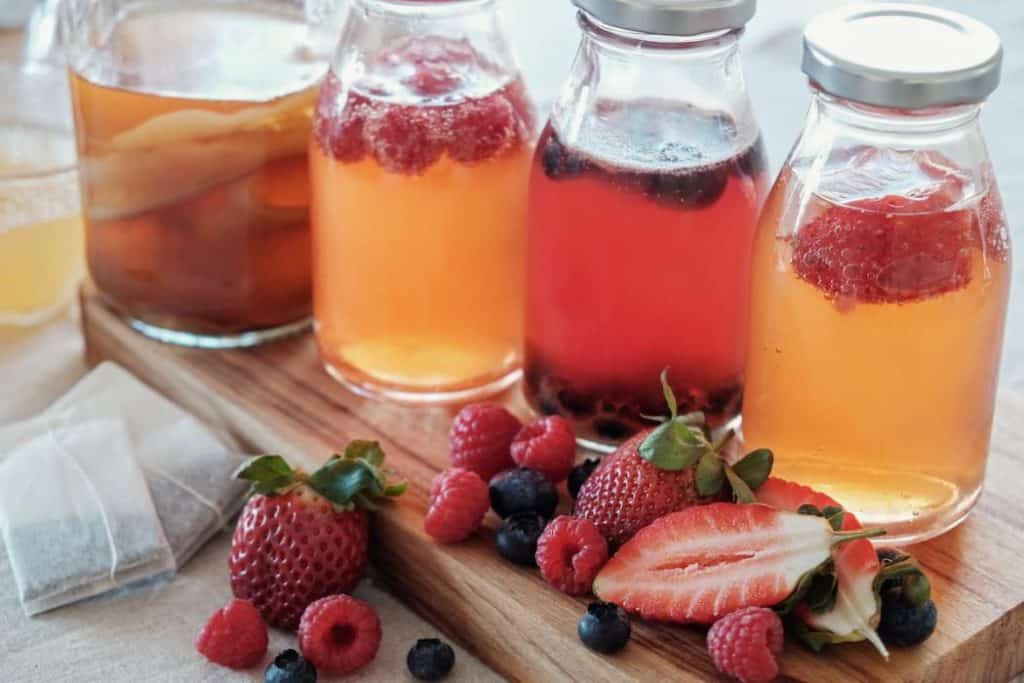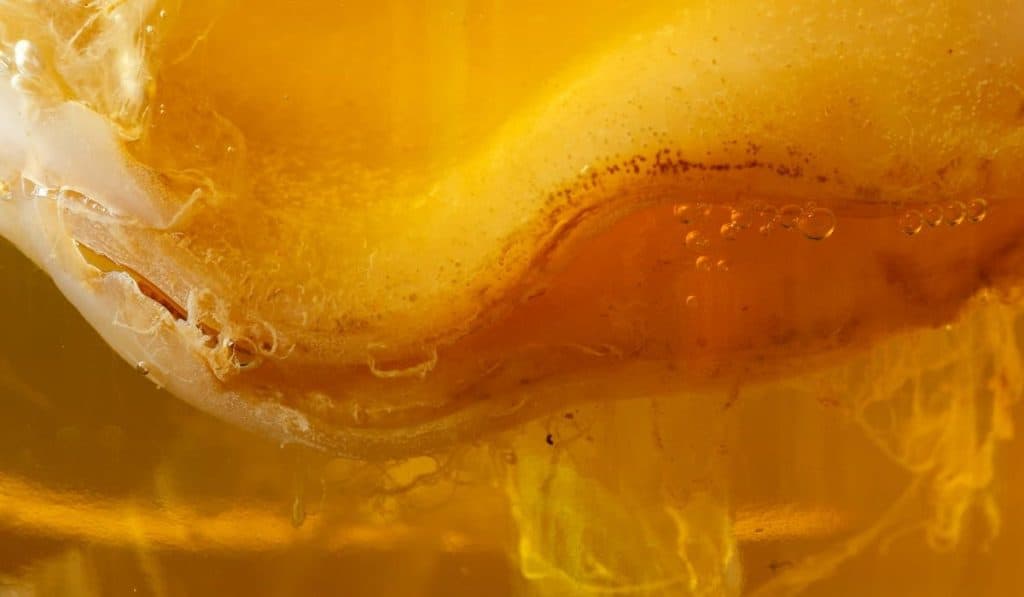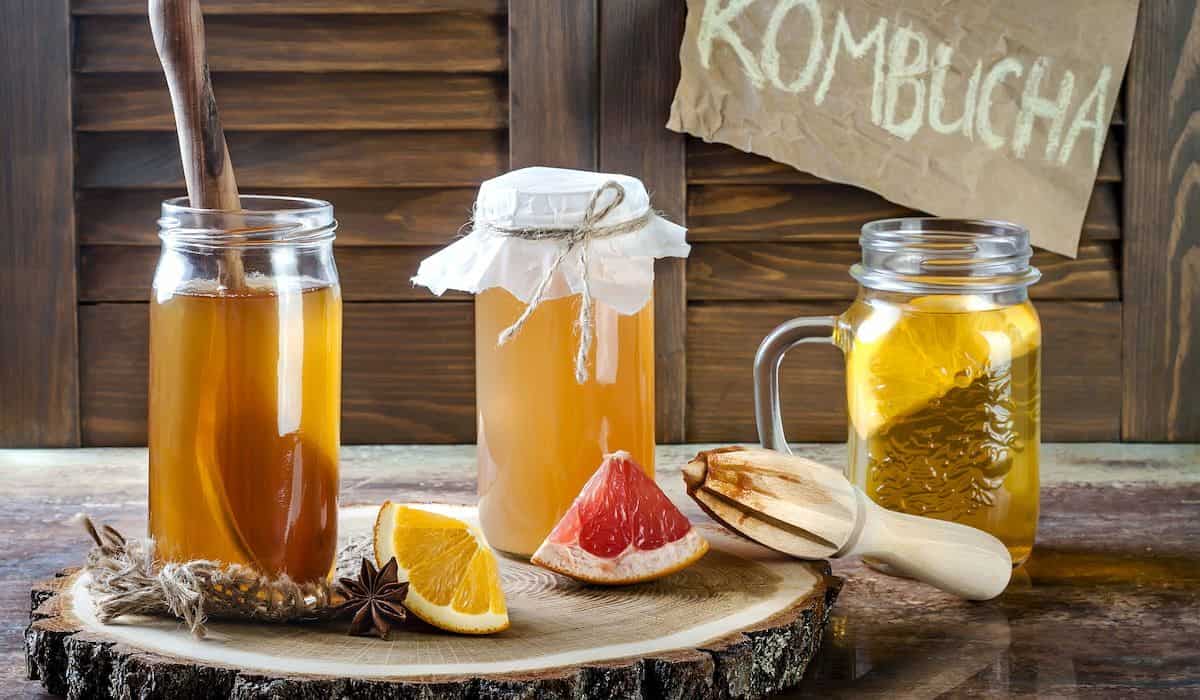Anyone that hasn’t brewed or tasted kombucha has heard about it. This tart and fermented beverage has become popular worldwide because of its health benefits and great taste.
It has grown to be one of the most sought after drinks in health stores and supermarkets worldwide.
If you’re a fan and are tired of spending a lot of money on kombucha, why not make your own at home?
As many people are becoming more health-conscious, kombucha brewing at home is becoming popular as a hobby.
Before we get into how to brew kombucha, let’s explore what it is and where it all started.
What is Kombucha?
In simple terms, kombucha is fermented tea. It is pronounced ‘kuhm-boo-chuh‘ and sometimes referred to as ‘fungus tea,’ ‘mushroom tea’ or ‘booch’. It looks cloudy with a pale or dark brown color.
This popular drink is made by introducing sugar, yeast, and a bacteria culture to green or black tea.
When the bacteria consume the sugar, it causes fermentation and creates its signature tarty (vinegar-like) taste and an effervescent quality that ardent kombucha consumers love.
Different types of flavors and juices can be added to create unique kombucha blends.

Where Did Kombucha Brewing Start?
The origin of kombucha brewing is not entirely clear as many legends are floating around today.
The most popular myth states that kombucha was first brewed around 200 B.C in Northeast China (historically known as Manchuria) by Emperor Qin Shi Huangdi.
It’s on record that tea and fermentation were quite popular in China at the time, so it’s only reasonable to tie it to the origin of kombucha brewing.
In 414 AD it is believed that a Korean doctor named Dr. Kombu brought the beverage to Japan as medicine for the Japanese Emperor Inkyo’s (Ingyo) digestive issues.
The emperor was impressed with the drink’s healing properties and named it after Dr. Kombu, adding the term ‘cha,’ which means ‘tea’ in Japanese.
Between 1913 and 1917, kombucha became popular in Germany and Russia, with health practitioners using it to treat their patients.
Dr. Rudolf Sklenar, a German physician, used it successfully for many years to treat several ailments.
In the 1990s, kombucha gained meaningful popularity, and the first kombucha brand was founded in America by American businessman George Thomas Dave.
He attributes his mother’s recovery from cancer to the medicinal drink.
Why Kombucha Brewing is A Good Hobby
If you’re already a fan of kombucha, it may come easier for you to want to start brewing it as a hobby.
Even if you’re just hearing about it now, there’s no reason why you shouldn’t try it.
Here are a few good reasons why kombucha brewing is a good hobby:
Creates a Community
Kombucha brewing can help create communities where people come together to participate in an activity that they enjoy.
They can be online or physical communities. Members can share experiences, advice, and information regarding their common hobby.
They can also hold social activities like workshops and events that raise the awareness of kombucha brewing and why it’s essential.
These communities are also an avenue to get to know people and make new friends who become meaningful connections for life.
Fun
Kombucha brewing is a fun experience. Putting ingredients together and seeing what comes out of it at the end is an achievement and gives you a satisfying feeling.
The most fun part about the process is where you get to jazz up your kombucha with flavor.
At the secondary fermentation stage, you get to customize your ‘booch’ to your tastes and preference.
You can add fruit purees, herbs, or fresh fruit to the storage bottles.
You have an opportunity to experiment and be creative by coming up with your own original flavors.
It’s a beautiful sight watching the tea color change into fruit colors.
Inexpensive
Store-bought kombucha costs a fortune over time. One bottle will set you back around $3 to $5. Not much, “you say”.
But this does add up over time. Making it at home will cost you less than a dollar per bottle. You’ll save lots of money brewing it yourself.
The great thing is you don’t need expensive ingredients or equipment.
You will only require water, SCOBY, tea bags, and a bit of sugar (only enough to feed the bacteria).
You can also use basic equipment like a glass jug, mason jars, a funnel, and a strainer, which are probably already in your kitchen.

Easy Process
The thought of fermenting any food or drink yourself sounds intimidating, but it shouldn’t be. First, you have to get a slice of SCOBY.
It’s a great idea to make your own, but just in case you’re stuck, you have options.
You can simply buy one or borrow some from a friend.
After that, all you’ll need to do is brew the tea, add the SCOBY to it and let it sit for a week or so.
After doing it once or twice, you’ll have mastered the process.
Don’t worry if it doesn’t come out right the first time. With more practice, you’ll get better each time.
You Know What You’re Drinking
Several noteworthy brands brew high-quality, tasty kombucha that’s great for your health.
However, as the market expands, many of these brands resort to taking shortcuts.
For example, they choose to add probiotics at the end of the process instead of brewing it properly from scratch.
Sometimes they put insane amounts of sugar for flavor. When you brew kombucha yourself, you know exactly what’s going into it.
You can freely pick out your tea of choice to use, whether it’s black, green, or oolong tea.
You can also select what you prefer to add, for instance, raspberries or mint.
Health Benefits
It is common knowledge that real fermented foods are important for gut health.
Medical practitioners believe that many chronic ailments in human beings start from the gut, so if it’s kept healthy, the immune system will become stronger.
A robust immune system also improves mental health and reduces chronic inflammation.
This goes to show you that it’s worth the time you will spend brewing kombucha every couple of days.
Sharable
You can make kombucha and share a bottle or two with your neighbors and friends out of kindness.
Some of them might not know what it is, or they do but don’t know how to make it and couldn’t be bothered. The great thing is it doesn’t cost much to make.
Sharing food and drink reminds people of what it’s like to be cared for and loved.
It’s a great gesture that they will appreciate, and it will go a long way in strengthening bonds and improving relationships.
Teaches Patience
Kombucha is not an instant beverage. It takes time to brew. Part of kombucha brewing (or brewing of any kind) is the procedure and the waiting.
This teaches you the value of a process and the importance of patience.
It shows you that creating good things take time and must go through certain stages.
Imagine if you drank your kombucha before the required fermentation time.
It would not taste great and wouldn’t have the fizz and effervescence that people enjoy.
This will positively affect other areas of your life where you need to exercise patience for a process to work.
What You Will Need
As mentioned before, the ingredients and equipment you need to brew kombucha are mostly basic and inexpensive.
The small investment you make will be worth it in the end. Here’s what you need to brew kombucha:
Basic Ingredients
Much as these ingredients are easily available, not just any will do. It’s important to note that you must find the right ingredients for a healthy SCOBY and tasty ‘booch’.
Water
You can’t use just any water to brew kombucha. No matter where you live, your tap water may be contaminated with chlorine and other contaminants.
This will affect the SCOBY and flavor of your kombucha.
Distilled water isn’t a good option either because it’s stripped of all the minerals that are helpful with the fermentation process.
Filtered water is the best choice for brewing kombucha. Simply purchase and install a water filter in the faucet or under your sink.
That way, the water is automatically purified as it comes out of the tap.
Alternatively, you can purchase a filter jug that comes with an activated charcoal filter.
Tea
You can’t brew kombucha without tea. Tea is an essential ingredient for the growth and quality of your SCOBY.
The best leaves are from the Camellia sinensis plant. This plant contains caffeine, nitrogen, and theanine, which help the kombucha to thrive.
It’s essential to use the right tea so that your kombucha tastes excellent.
Use organic black, green, white, or oolong tea. You can combine different tea leaves to create unique tea blends.
Avoid scented or flavored teas as they contain chemicals that may interfere with your ‘booch’.
Also, herbal teas like chamomile are not recommended as they may have natural oils that will interfere with the SCOBY’s growth.
Sugar
It’s not kombucha without sugar. Sugar plays a crucial role in feeding the bacteria and yeast to aid its growth.
Without it, there won’t be bacteria and yeast, and that means no kombucha.
You might be thinking that the sugar is too much for you, but most of it gets consumed during fermentation. The best sugar to use is organic cane or white sugar.
Sugar alternatives like honey, maple syrup, stevia, agave, xylitol, and palm sugar are not recommended because they do not contain the right nutrients to feed the SCOBY.
Brown and whole sugar are hard on the kombucha and make it yeasty.
Starter Tea
The health of the SCOBY is dependent on an acidic liquid called starter tea.
Starter tea is raw, aged, and healthy kombucha taken from a previous batch of kombucha.
Usually, brewers reserve about 12 ounces of kombucha from 1 gallon of their last batch to start the next one.
The starter tea plays a crucial role in inoculation by introducing the bacteria and yeast into fresh tea to start fermentation.
If you don’t have any starter tea or can’t get it from another brewer, your next best option is to buy a bottle of raw, unflavored kombucha tea from the store.
SCOBY (Symbiotic Culture of Bacteria and Yeast)
This rubbery, opaque disk, also known as the kombucha mother, is a living home for bacteria and yeast.
It’s how sweet tea turns into kombucha. Each time you make a new batch, a new SCOBY film will grow across the liquid’s surface.
If you don’t have a SCOBY, you can ask a friend to lend you one or find out from fellow brewers on your local online community platform.
It should have a vinegar-like smell. If it has a cheese-like odor or you notice any mold, it’s decaying and must be discarded immediately.

Equipment
This list of brewing tools may make you wonder if it’s cheaper to brew kombucha. Yes, it is.
Remember you only buy them once in a long time, and you can get them cheaply from flea markets or online. Here’s the list:
1. Gallon Glass Jar
Kombucha brewing requires a glass jar because glass does not react to the acidity of the ‘booch’. It’s also free from chemicals like BPA and doesn’t scratch easily.
Glass jars are inexpensive and easy to obtain.
Your local store or retail stores like Walmart and Target may have these available.
You can also order them from Amazon, where they come in packs of 2 or 4 for a great price.
Keep in mind that many glass jars have metallic or plastic spigots, which are not safe for high acidity drinks like kombucha.
The best spigots are made from wood or stainless steel and must be frequently removed for washing.
2. Muslin Cloth and Large Rubber Band
Fermenting food or drink always attracts fruit flies and other small insects. They enjoy feeding on sugar in ferments.
To keep them out and avoid contamination of the kombucha, you need a cover.
Avoid tight lid covers as the kombucha needs sufficient airflow to ferment properly.
It’s best to use a breathable cloth-like butter muslin or a tight-weave dishcloth, then secure it with a rubber band.
It’s never a good idea to use cheesecloth as it’s porous and can allow gnats and fruit flies to sneak their way through its layers.
Folding it over several times will not help much.
3. Tea/Boiling Pot
Although we pay more attention to the brewing process, the container you use to boil the tea is also important.
It’s advisable to keep your sweet teapot separate from other pots.
It makes cleaning easier and reduces the chances of contamination if the pot you used to make pasta wasn’t cleaned properly.
A high-quality stainless-steel pot is highly recommended as it is non-reactive and won’t contaminate the tea with chemicals.
It’s a good idea to get a big 5-gallon pot so that you can brew as little or as much kombucha as you want without having to switch pots.
You can also use a glass pot if you’re making a small quantity of ‘booch’.
If you can avoid reactive materials like cast iron, aluminum, ceramic-coated or Teflon-coated pots, the better.
4. Wooden Spoon
The spoon’s purpose is to stir in the sugar once you’ve taken the pot off the fire.
Avoid using a metal spoon as the acids in the kombucha culture will leach metal compounds, especially if there’s prolonged contact.
This will affect the SCOBY and contaminate the ‘booch’.
5. Funnel
You may only use this once for a few minutes during the process, but it’s an important tool even if you have steady hands and a keen eye.
You’ll need a funnel to guide the tea into your storage bottles as they typically have thin spouts and necks.
You can use the BPA-free plastic ones or the silicone type that’s collapsible and easy to store.
6. Mesh Strainer
A metal-free, BPA-free strainer comes in handy to keep yeast strings from getting into your brewed kombucha.
You can also use it to scoop the SCOBY out. Also, it helps with straining loose-leaf tea and fruit. Some stainless-steel funnels come with removable strainers, so that’s an option too.
7. Storage Bottles
Glass bottles are perfect for storing kombucha as they do not react with the acid and are easy to clean.
Flip-top bottles, also known as Grolsch bottles, are popular with many homebrewers because they have airtight seal caps.
Only use ceramic or porcelain containers if they are food grade. Avoid plastic, metal, and crystal bottles.
8. Stick-On Thermometer
The right temperature is vital for the perfect homemade brew. Using a stick-on thermometer will help you to monitor the temperature of your ‘booch’ easily.
The best brewing temperature is between 75 to 85°F or 24 to 30°C.
These can be bought individually or as part of a Kombucha Tea Starter Kit.
9. Re-Usable Tea Bags
These will come in handy when steeping loose leaf tea.
10. pH Strips
pH test strips help you determine whether your ‘booch’ is fermenting properly.
A safe pH should be below 4, ideally between 2.5 and 3.5, to prevent mold growth and harmful microorganisms.

Do-It-Yourself Kombucha Kits
Some stores and sites have created what they call a kombucha kit to make the entire process easier for you.
The kits typically contain a glass jar for brewing, SCOBY, organic black tea, organic white cane sugar, muslin jar cover, pH strips, stick-on thermometer, and organic distilled white vinegar.
You can start by using a starter kit as it also comes with instructions. Avoid using distilled vinegar that you may find in most kits. It is not the best choice as a starter ‘tea.’
Most kits only have enough ingredients for one batch of kombucha, so after that, you’ll have to buy your ingredients.
Where Can You Learn How to Brew Kombucha?
There’s a lot of conflicting free information on the internet that might confuse you, so the best way to learn how to brew kombucha is through expert brewers.
There are several online courses like Edible Alchemy Academy, Happy Bellyfish School, and kombucha-brewing master class at Mannanova.
To Sum It Up
Make kombucha brewing even more fun by doing it with friends or family.
You could decide to expand your love for kombucha into a thriving business eventually, but for now, enjoy it as a hobby.
After a long hard week, this activity will help you relax, have fun, boost your health, and enjoy a great-tasting beverage every day.




